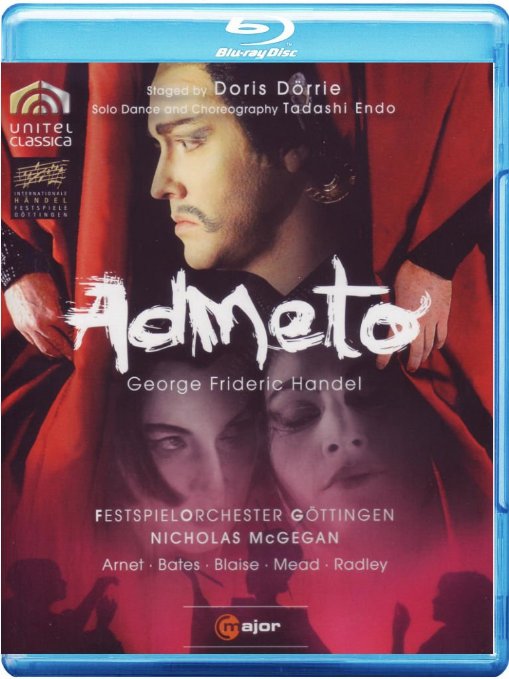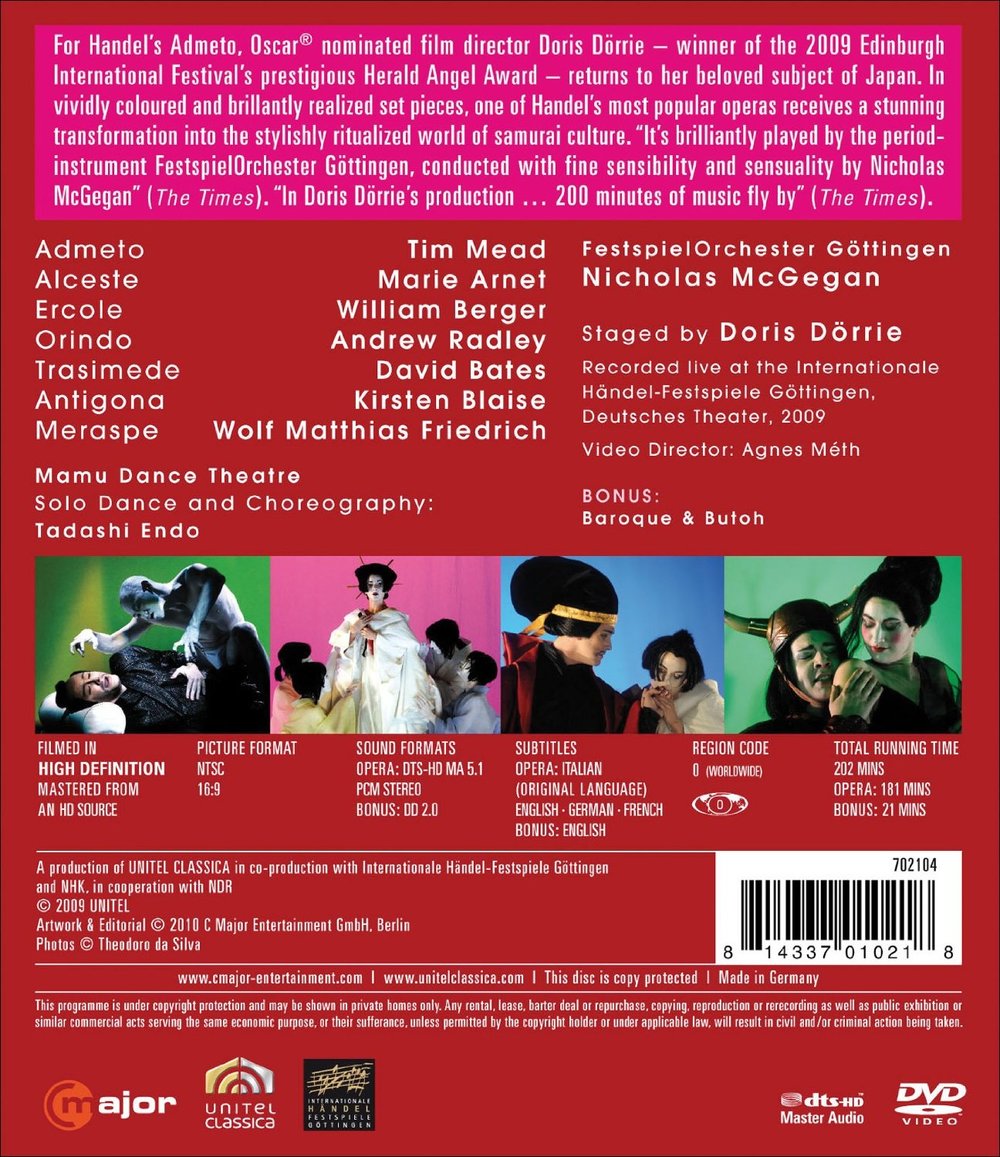

Handel Admeto opera to libretto by Nicola Haym or Paolo Antonio Rolli. Directed 2009 by Doris Dörrie at the Deutsches Theatre, Göttingen, Germany, as part of the Internationale Handel-Festspiele. (This is a completely different production than the Halle Admeto.) Singing stars are Tim Mead (Admeto), Marie Arnet (Alceste), William Berger (Ercole), Andrew Radley (Orindo), David Bates (Trasimede), Kirsten Blaise (Antgone), and Wolf Matthias Friedrich (Meraspe). Dancing by Tadashi Endo and members of the Mamu Dance Theatre. Nicholas McGegan conducts the Göttingen Festival Orchestra. Set and costume design by Bernd Lepel; lighting by Linus Fellbom; choreography by Tadashi Endo. Directed for TV by Agnes Méth. Released in 2010, this disc has 5.1 dts-HD Master Audio surround sound. Grade: F+
There are no videos of this obscure Handel opera other than subject title and the Halle Handel Festival version, both published in HDVD. Having viewed both of these titles several times, I'll testify that this opera is worthy of production today. If none of the major opera houses will stage it, we should be grateful to the folks at the festivals and smaller houses who will give it a spin. The folks at Göttingen came up with a lot of ideas to present in their tiny house. It's possible that the production was enjoyable live, even if it wilts before HDVD cameras and high-fidelity microphones. The recording suggests that the audience was enthusiastic. But there is no substantial picture of the audience, so there's no way to know if the applause was real or fake.
Picture quality is only fair. A lot of this opera plays out with reduced or one-color lighting---and both these conditions are challenging for the TV director. The FestspielOchester Göttingen put out a big sound for such a small number of musicians. Still, the quality of the FestspielOchester playing is below that of other period instrument orchestras I've heard on HDVDs. The recording of the orchestra and the singers is only fair; much of the time the sound balance between the orchestra and the singers is poor with the orchestra playing too load and the singers hard to hear.
Although the singing was good enough to be tolerated live by Handel fanatics, no singer in this show came up with a performance that most people would want to hear repeatedly. Tim Mead was acceptable as Trasimede in the Halle Handel Festival performance, but he doesn't have the horsepower to sing Admeto, the King. The two female leads were nice enough to look at, but their singing is too often marred by stumbling, harshness, and yelping. The singing of William Berger is acceptable as Ercole (Hercules) even though he wears a distracting consume. David Bates as Trasimede is pathetic (try chapter 32, my candidate for the worst aria ever presented on HDVD). The singing, orchestral performance, and recorded sound would indicate, I think, a grade of "D." It follows then that the further downgrade into F-land must come from design and direction.
The director decided to use Japanese design themes including: austere sets, Japanese inspired costumes from the Edo period, and samurai, sumo, and Butoh characters. Now you know that the samurai were medieval warriors and the sumo are the enormously fat Japanese wrestlers. But what the heck is Butoh? Wikipedia has pretty good coverage on it. Butoh has nothing to do with the Edo period of Japanese history. It's a modern performance art form. It typically features characters who appear naked (except for genital patches) and who, after months of training and starvation, enact shocking scenes like hanging upside down in public spaces before tumbling painfully down flights of stone steps and groveling in groups on sidewalks to the astonishment of innocent bystanders. Butoh can take as many forms as there are people to dream it up.
Butoh normally seems to make some point of social criticism and is therefore dead serious if not actually dangerous to perform. At first I concluded that bringing Butoh into a production shuts the door on anything funny. But I've changed my mind about that; the scene (see below) of the temptation of Ercole (Hercules) is proof that Butoh can be used in comic situations.
Still, when Doris Dörrie committed herself to Japanese design, I think she took on an obligation to honor the Japanese code of elegant design in all things, exquisite fit and finish, and total artistic perfection. This was a task hopelessly beyond the capabilities of the Göttingen festival budget. Consider the wigs. Many of the singers wear Japanese-style wigs. They all appear to be made of plastic filaments rather than some kind of hair. Many of the wigs are hugely lumpy. All are crudely put together and contrast sharply with the skin of the performers. This probably didn't look very good live, but it is startlingly shabby in HDVD. The make-up is just as bad. I get the impression that each signer got a little kit with printed instructions on how to make up himself.
Now everyone knows that kimonos and samurai armor are among the most beautiful garments ever made. So the designers here didn't try to do anything authentic. The costumes were "inspired" by the real thing. Well even that goal is pretty daunting, and what the costume shop came up with looks sadly disheveled and trashy. The warrior gear given to Trasimede could only have been originally designed for comic effect. But the greatest design hoot of all would have to be the Hercules sumo "fat suit." A lot of opera singers are too fat, but none of them are a big as a sumo wrestler. So they outfitted William Berger with a padded garment complete with painted nipples and stitched seams to simulate pectoral musculature.
The Butoh performance art is provided by Tadashi Endo and the Mamu Dance Theater. Although I would not want to see this Admeto video yet again, I would welcome opportunity to see a dance title by Endo and his followers.
Time now for some screen shots. Admeto the King is ill. Note the wig and mustache makeup:
Admeto's wife, Alceste, attends him. What is she wearing?
An oracle says that the King will recover only if someone close to him sacrifices his life. Alceste resolves to save the King. Note the Alceste makeup:
And the Alceste wig:
There is no scenery until the end of this long opera; here is a typical set showing Alceste with her maidens:
Alcesto and the maidens (played by Butoh dancers) prepare for Alceste's suicide. More ugly wigs:
With Alceste dead and Admeto recovered, Antigone, a Trojan princess, has a shot at marriage to Admeto. Antigone is disguised as a shepherdess. Here are some shots of Antigone and other characters linked to her. (In one shot, Antigone is seen sitting on a ram portrayed by a Butoh dancer.) What do you think of the designs?:
Here's a shot of the Butoh sheep herd:
Alceste has committed suicide and is tormented in hell by Butoh devils. Ercole (dressed as Sumo wrestler) rescues Alceste:
Since the devils are not strong enough to defeat Ercole, they use a more devious tactic to stop him from returning Alceste to Admeto:
Ercoles rebuffs the devils:
The devils are persistent:
But nothing can stop our hero:
Now two women have designs on the King. But there will be a happy ending for all. The director suddenly provides scenery for a 19th century palace, probably because the complicated business in the finale requires plenty of doors and windows. But what is that weird art-deco chandelier doing in this setting?
Considering all the weakness in this production mentioned above and the general cheapness of the design, I don't see how the grade could be higher than a "F." I doubt this title was worth publishing especially when we have a better Admeto from the Halle Handel Festival. But I will move the grade up a notch to "F+." There could be some merit in this show that I don't recognize; for example, someone interested in Butoh might find this title worth buying.
Finally, the following thought crossed my mind: perhaps its very badness of this HDVD will make it one day into a cult classic. Maybe HDVD fans will buy this title to show in their home theaters just as movie fans now buy the worst films ever made (like Glen or Glenda or Plan 9 from Outer Space). And there's also the precedent of the Rocky Horror Picture Show. Maybe one day our Admeto will be shown in movie theaters where guys in fat suits will step into aisles and girls will strip to slather them with temptations.
Or, you can buy this title from Presto. The original package for this had artwork from 2010. Presto has the same title that was issued in 2016 with different artwork.
















